Spatiotemporal Dynamics and Driving Factors of Urban Green Space in Texas (2001–2021): A Multi-Source Geospatial Analysis
Abstract
1. Introduction
- (1)
- How does urban expansion affect green space resources in terms of spatial differentiation and use transformation across large geographical regions?
- (2)
- Do different types of cities exhibit consistent spatiotemporal distribution patterns when green spaces are replaced by low, medium, or high-density urban areas?
- (3)
- What are the differences in the driving effects of socioeconomic factors (such as population, GDP) and policy orientation on green space occupation and changes across the 254 counties of Texas?
2. Materials and Methods
2.1. Study Area: Texas in the Directly Reflecting Shifts in Land Use U.S.
2.2. Data Source
2.2.1. Land Use Dataset
2.2.2. Encroachment Intensity (EI)
2.2.3. Urban–Rural Classification
2.2.4. Population and GDP Data
2.2.5. Texas Building Typology Dataset
2.3. Methods
2.3.1. Methodology
2.3.2. Land Use Transition Matrix
2.3.3. Annual Change Rate of Individual Land Use
2.3.4. Spatial Statistics on Different Types of Urban Green Space Change
- (1)
- MSA vs. Non-MSA: According to the U.S. government’s definition of Metropolitan Statistical Areas (MSAs), counties within an MSA are categorized as one group, while the remaining counties are classified as another. Numerous studies have shown that MSA regions typically exhibit more prominent urbanization, higher population growth, and greater economic development, all of which have a more pronounced impact on land use change, especially green space conversion.
- (2)
- Different Urbanization Levels: This study adopts a county classification method currently used by the American Cancer Society (ACS). When conducting cancer screening and differential reporting across the United States, the American Cancer Society uses this classification and naming approach. Based on this, counties are classified into different levels of urbanization, such as large metropolitan counties, small-to-medium metropolitan counties, and nonmetropolitan counties [33].
- (3)
- Geographic Location Characteristics: The 254 counties are divided into three categories based on geographic characteristics as follows: coastal counties (those bordering the Gulf of Mexico), inland border counties (those bordering the Mexican border), and other inland counties.
2.3.5. GIS-Based Spatial Analysis of Green Space Conversion Types
- (1)
- Calculating the geometric centroid of each building using ArcGIS 10.8.
- (2)
- Applying the “Select by Location” tool with the spatial relationship set to “Center within features,” where features in the input layer are selected if their centers fall within a chosen feature (for polygons and multipoints: geometric centroid is used; for line inputs: midpoint of the geometry is used).
2.3.6. Bivariate Mapping and Linear Regression
3. Results
3.1. Transitions Between Green Space and Built-Up Areas
- (1)
- 2001–2006: Built-up areas increased slightly, with major expansion occurring around large cities.
- (2)
- 2006–2011: The expansion rate accelerated, with surrounding green spaces and agricultural land being significantly occupied.
- (3)
- 2011–2016: The urban boundary continued to expand, and the reduction of green spaces persisted.
- (4)
- 2016–2021: The urbanization process intensified, and the newly added built-up areas continued to occupy green and agricultural land at a high intensity.
3.2. The Encroachment of Green Space in Different County Classifications
3.2.1. Classification of Counties by MSA List
3.2.2. Classification of Counties by Urbanization Level
3.2.3. Classification of Counties by Geographic Location
3.3. Types of Green Space Occupied by Urban Built-Up Areas
3.4. Bivariate Choropleth Map and Linear Regression
- (1)
- Population Change vs. Green Space ChangeSome counties exhibit “rapid population growth but insignificant green space reduction” or “population decrease but significant green space reduction”.
- (2)
- GDP Change vs. Green Space ChangeSome counties show “GDP growth but insignificant green space reduction” or “GDP decline but significant green space reduction”.
4. Discussion
4.1. Spatiotemporal Patterns of Green Space Changes in Different Types of Cities
4.2. Socioeconomic Drivers of Green Space Change
- (1)
- Population Growth but Insignificant Green Space Reduction: This may occur in regions where, despite rapid urbanization, well-established green space protection or land use planning policies were implemented. Alternatively, changes in agricultural land or other land types may have interfered with the green space data, making it appear that green space has not been significantly occupied.
- (2)
- Population Decrease but Significant Green Space Reduction: This could be related to economic recession, weak government oversight, or outdated urban planning. Green space may have been destroyed due to lack of maintenance or illegal development. During industrial shifts, some regions may have been influenced by external investments or short-term development activities, leading to the one-time occupation of green space without a population return.
- (3)
- GDP Growth but Insignificant Green Space Reduction: Some regions may have simultaneously advanced economic development and ecological construction, such as implementing ecological compensation or vertical greening and public green space renovation in built-up areas, thus slowing actual encroachment on green space. If GDP growth in the area mainly relies on sectors with relatively small spatial demands, such as non-manufacturing or information industries, the actual expansion of land use may not be significant.
- (4)
- GDP Decline but Significant Green Space Reduction: This could be due to a lack of effective management during economic contraction, with green spaces facing random development or improper land reuse. In cases of fiscal stress and planning defects, green spaces are vulnerable to being sold off or repurposed for other uses, accelerating their degradation.
4.3. Green Space Occupation
4.4. Limitations of the Study
- (1)
- Satellite Data Accuracy and Recognition Limitations: The identification of low-density and medium-density built-up areas still mainly relies on the coverage percentage of impervious surfaces in satellite products. Different levels of urban built-up areas may suffer from ambiguous identification and errors in actual statistical results. Higher-resolution imagery or ground survey data are needed for further correction.
- (2)
- Limited Types of Driving Factors: This study primarily focuses on population, GDP, urban rank, and geographic location, exploring their correlations with green space changes without conducting an in-depth analysis of climatic and environmental factors. This decision was based on several considerations: first, urban expansion and the reduction of green spaces are predominantly driven directly by socioeconomic factors, while the impact of climate change tends to be relatively indirect [21]; second, numerous studies have already examined the effects of climatic factors on ecosystems, and the current study aims to complement this by focusing specifically on anthropogenic factors [27]; additionally, due to constraints in data availability and methodological approaches, this research is better suited to examining the role of socioeconomic variables in green space conversion rather than the effects of long-term climate trends [3]. Future research could further integrate climate change data to investigate the long-term impacts of extreme weather events on green space protection and urban planning.
- (3)
- Lack of Policy Factors: The success of green space protection in some exceptional areas is closely linked to the active intervention of local policies. Including policy dimensions in the research would help to better understand the role and influence mechanisms of local governments in regulating urban land expansion.
5. Conclusions
Author Contributions
Funding
Data Availability Statement
Acknowledgments
Conflicts of Interest
References
- Mitchell, R.; Popham, F. Effect of exposure to natural environment on health inequalities: An observational population study. Lancet 2008, 372, 1655–1660. [Google Scholar] [CrossRef] [PubMed]
- Zhao, J.; Chen, S.; Jiang, B.; Ren, Y.; Wang, H.; Vause, J.; Yu, H. Temporal trend of green space coverage in China and its relationship with urbanization over the last two decades. Sci. Total Environ. 2013, 442, 455–465. [Google Scholar] [PubMed]
- Smith, J.; Brown, K.; Thompson, R. The impact of extreme climate events on land use change in Texas. J. Clim. Adapt. 2022, 15, 221–234. [Google Scholar]
- Teeuwen, R.; Milias, V.; Bozzon, A.; Psyllidis, A. How well do NDVI and OpenStreetMap data capture people’s visual perceptions of urban greenspace? Landsc. Urban Plan. 2024, 245, 105009. [Google Scholar] [CrossRef]
- Dallimer, M.; Tang, Z.; Bibby, P.R.; Brindley, P.; Gaston, K.J.; Davies, Z.G. Temporal changes in greenspace in a highly urbanized region. Biol. Lett. 2011, 7, 763–766. [Google Scholar] [CrossRef]
- Liu, S.; Zhang, X.; Feng, Y.; Xie, H.; Jiang, L.; Lei, Z. Spatiotemporal dynamics of urban green space influenced by rapid urbanization and land use policies in Shanghai. Forests 2021, 12, 476. [Google Scholar] [CrossRef]
- Heo, S.; Bell, M.L. Investigation on urban greenspace in relation to sociodemographic factors and health inequity based on different greenspace metrics in 3 US urban communities. J. Expo. Sci. Environ. Epidemiol. 2023, 33, 218–228. [Google Scholar] [CrossRef]
- Dinda, S.; Das, P.; Dutta, D. Assessing the impact of urban land-use dynamics on the ecological vulnerability of Kolkata Municipal Corporation (KMC), India. In Urbanization and Regional Sustainability in South Asia: Socio-Economic Drivers and Environmental Concerns; Mandal, D., Dutta, D., Mukhopadhyay, A., Eds.; Springer: Cham, Switzerland, 2021; pp. 495–512. [Google Scholar] [CrossRef]
- Hunter, R.F.; Cleland, C.; Cleary, A.; Droomers, M.; Wheeler, B.W.; Sinnett, D.; Nieuwenhuijsen, M.; Braubach, M. Environmental, health, wellbeing, social and equity effects of urban green space interventions: A meta-narrative evidence synthesis. Environ. Int. 2019, 130, 104923. [Google Scholar] [CrossRef]
- Kabisch, N.; Korn, H.; Stadler, J.; Bonn, A. (Eds.) Nature-Based Solutions to Climate Change Adaptation in Urban Areas: Linkages Between Science, Policy and Practice; Springer: Cham, Switzerland, 2017. [Google Scholar] [CrossRef]
- Texas Land and Resource Management Act. Texas Land and Resource Management Act 2019; Texas State Legislature: Austin, TX, USA, 2019. [Google Scholar]
- Wulder, M.A.; White, J.C.; Loveland, T.R.; Woodcock, C.E.; Belward, A.S.; Cohen, W.B.; Fosnight, E.A.; Shaw, J.; Masek, J.G.; Roy, D.P. The global Landsat archive: Status, consolidation, and direction. Remote Sens. Environ. 2018, 185, 271–283. [Google Scholar] [CrossRef]
- Zhu, X.; Tuia, D.; Mou, L.; Xia, G.S.; Zhang, L.; Xu, F.; Fraundorfer, F. Deep learning in remote sensing: A comprehensive review and list of resources. IEEE Geosci. Remote Sens. Mag. 2017, 5, 8–36. [Google Scholar] [CrossRef]
- Chen, B.; Wu, S.; Song, Y.; Webster, C.; Xu, B.; Gong, P. Contrasting inequality in human exposure to greenspace between cities of Global North and Global South. Nat. Commun. 2022, 13, 4636. [Google Scholar] [CrossRef]
- Halder, B.; Bandyopadhyay, J.; Al-Hilali, A.A.; Ahmed, A.M.; Falah, M.W.; Abed, S.A.; Yaseen, Z.M. Assessment of urban green space dynamics influencing the surface urban heat stress using advanced geospatial techniques. Agronomy 2022, 12, 2129. [Google Scholar] [CrossRef]
- Ali, G.; Pumijumnong, N.; Cui, S. Valuation and validation of carbon sources and sinks through land cover/use change analysis: The case of Bangkok metropolitan area. Land Use Policy 2018, 70, 471–478. [Google Scholar] [CrossRef]
- Xing, Z.; Zhao, S.; Li, K. Evolution pattern and spatial mismatch of urban greenspace and its impact mechanism: Evidence from parkland of Hunan Province. Land 2023, 12, 2071. [Google Scholar] [CrossRef]
- Kitch, J.C.; Nguyen, T.T.; Nguyen, Q.C.; Hswen, Y. Changes in the relationship between Index of Concentration at the Extremes and US urban greenspace: A longitudinal analysis from 2001–2019. Humanit. Soc. Sci. Commun. 2023, 10, 862. [Google Scholar] [CrossRef]
- Prăvălie, R.; Borrelli, P.; Panagos, P.; Ballabio, C.; Lugato, E.; Chappell, A.; Birsan, M.V. A unifying modelling of multiple land degradation pathways in Europe. Nat. Commun. 2024, 15, 3862. [Google Scholar] [CrossRef]
- Seto, K.C.; Güneralp, B.; Hutyra, L.R. Global urban land expansion and its effects on biodiversity. Proc. Natl. Acad. Sci. USA 2011, 108, 7687–7692. [Google Scholar]
- Zhu, Z.; Liu, B.; Wang, H.; Hu, M. Analysis of the spatiotemporal changes in watershed landscape pattern and its influencing factors in rapidly urbanizing areas using satellite data. Remote Sens. 2021, 13, 1168. [Google Scholar] [CrossRef]
- Schinasi, L.H. Green space and gentrification in 43 US metropolitan areas. Environ. Res. 2021, 200, 111751. [Google Scholar]
- Ducey, M.J.; Johnson, K.M.; Belair, E.P.; Cook, B.D. The influence of human demography on land cover change in the Great Lakes States, USA. Environ. Manag. 2018, 62, 1089–1107. [Google Scholar] [CrossRef]
- Zhou, W.; Wang, J.; Qian, Y.; Pickett, S.T.; Li, W.; Han, L. The rapid but “invisible” changes in urban greenspace: A comparative study of nine Chinese cities. Sci. Total Environ. 2018, 627, 1572–1584. [Google Scholar] [PubMed]
- Song, Y.; Chen, B.; Kwan, M.P. How does urban expansion impact people’s exposure to green environments? A comparative study of 290 Chinese cities. J. Clean. Prod. 2020, 246, 119018. [Google Scholar]
- Wang, Q.; Takatori, C.; Chen, Z. Urban dynamics and their implication on greenness trends: A 25-year retrospective study of the changing face of Tokyo metropolitan area. Environ. Sustain. Indic. 2024, 23, 100427. [Google Scholar] [CrossRef]
- Haaland, C.; van den Bosch, C.K. Challenges and strategies for urban green-space planning in cities undergoing densification. Urban For. Urban Green. 2015, 14, 760–771. [Google Scholar]
- National Centers for Environmental Information (NCEI). Climate Data Summary for Texas; National Oceanic and Atmospheric Administration (NOAA): Silver Spring, MD, USA, 2023. [Google Scholar]
- US Census Bureau. Texas Population Passes the 30-Million Mark in 2022; U.S. Census Bureau: Washington, DC, USA, 2023. [Google Scholar]
- Zhang, L.; Li, M. Urban sprawl and green space loss in Texas: A case study. J. Urban Plan. 2021, 39, 112–130. [Google Scholar]
- Liu, X.; Wang, Y.; Chen, Z. The impact of population growth on land use and infrastructure development in Texas. Urban Dev. Rev. 2019, 27, 85–102. [Google Scholar]
- Johnson, R.; Smith, M. Economic growth and land use policies: Implications for urban green space in Texas. J. Environ. Manag. 2022, 58, 54–70. [Google Scholar]
- Islami, F.; Baeker Bispo, J.; Lee, H.; Wiese, D.; Yabroff, K.R.; Bandi, P.; Sloan, K.; Patel, A.V.; Daniels, E.C.; Kamal, A.H.; et al. American Cancer Society’s report on the status of cancer disparities in the United States, 2023. CA Cancer J. Clin. 2024, 74, 136–166. [Google Scholar]
- Chen, B.; Nie, Z.; Chen, Z.; Xu, B. Quantitative estimation of 21st-century urban greenspace changes in Chinese populous cities. Sci. Total Environ. 2017, 609, 956–965. [Google Scholar] [CrossRef]
- Schinasi, L.H.; Cole, H.V.; Hirsch, J.A.; Hamra, G.B.; Gullon, P.; Bayer, F.; Lovasi, G.S. Associations between greenspace and gentrification-related sociodemographic and housing cost changes in major metropolitan areas across the United States. Int. J. Environ. Res. Public Health 2021, 18, 3315. [Google Scholar] [CrossRef]
- Balland, P.A.; Jara-Figueroa, C.; Petralia, S.G.; Steijn, M.P.; Rigby, D.L.; Hidalgo, C.A. Complex economic activities concentrate in large cities. Nat. Hum. Behav. 2020, 4, 248–254. [Google Scholar] [CrossRef] [PubMed]
- Ducey, M.J. Modeling urban land use change. Landsc. Urban Plan. 2018, 177, 47–56. [Google Scholar]
- Wolch, J.R.; Wilson, J.P.; Fehrenbach, J. The role of green spaces in urban environments and the socio-economic implications of their development. Urban Stud. 2014, 41, 241–258. [Google Scholar]
- Zhu, Z.; Zhang, Y.; Chen, X. Urbanization and green space dynamics in China: Evidence from Guangzhou. J. Environ. Manag. 2021, 289, 112478. [Google Scholar]
- Jim, C.Y. Sustainable urban green spaces in high-density cities. Landsc. Urban Plan. 2013, 126, 104–112. [Google Scholar]
- Zhao, P.; Lü, B.; Woltjer, J. Urban expansion and green space loss in China: A global perspective. Habitat Int. 2020, 96, 102124. [Google Scholar]
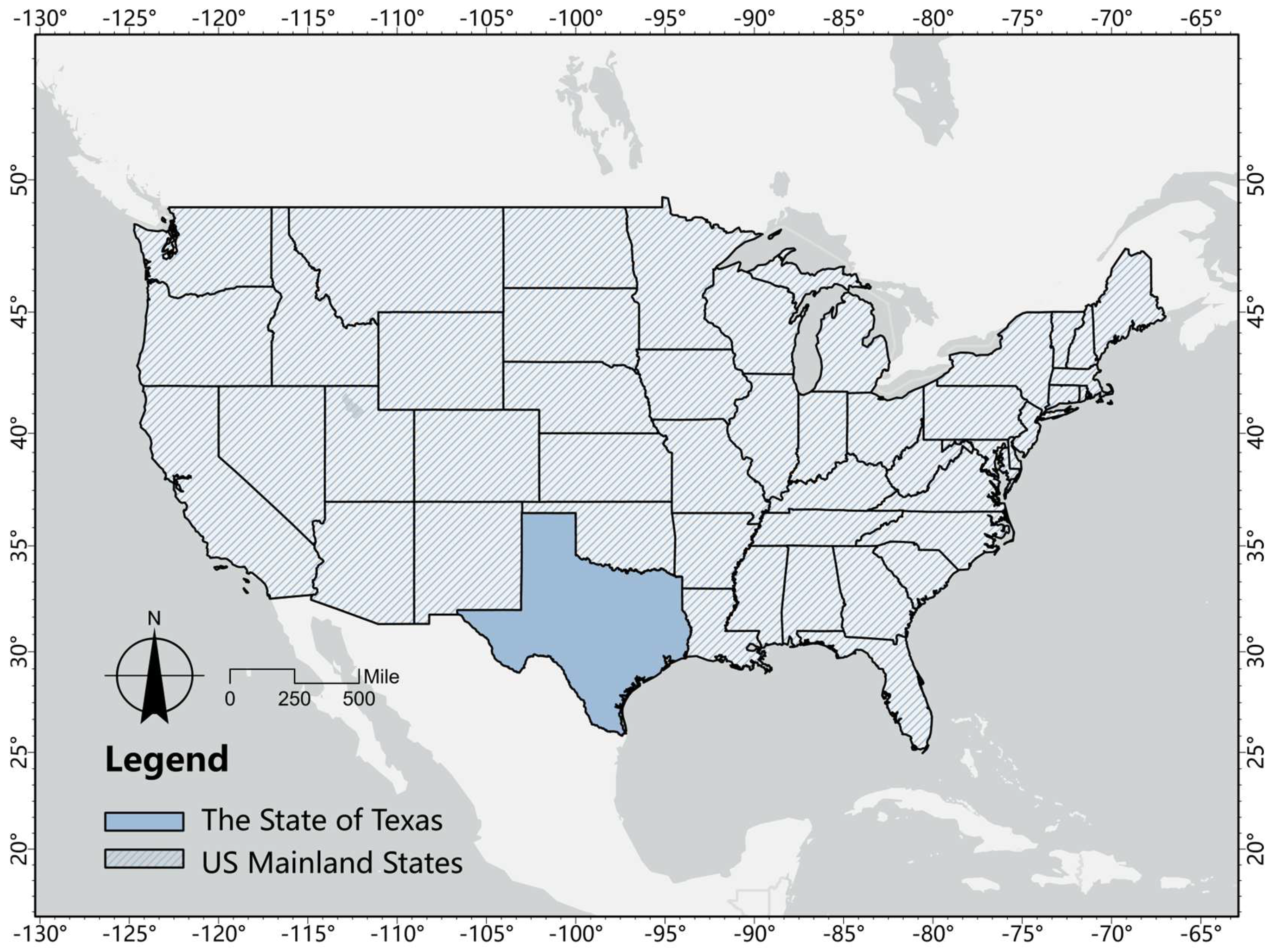
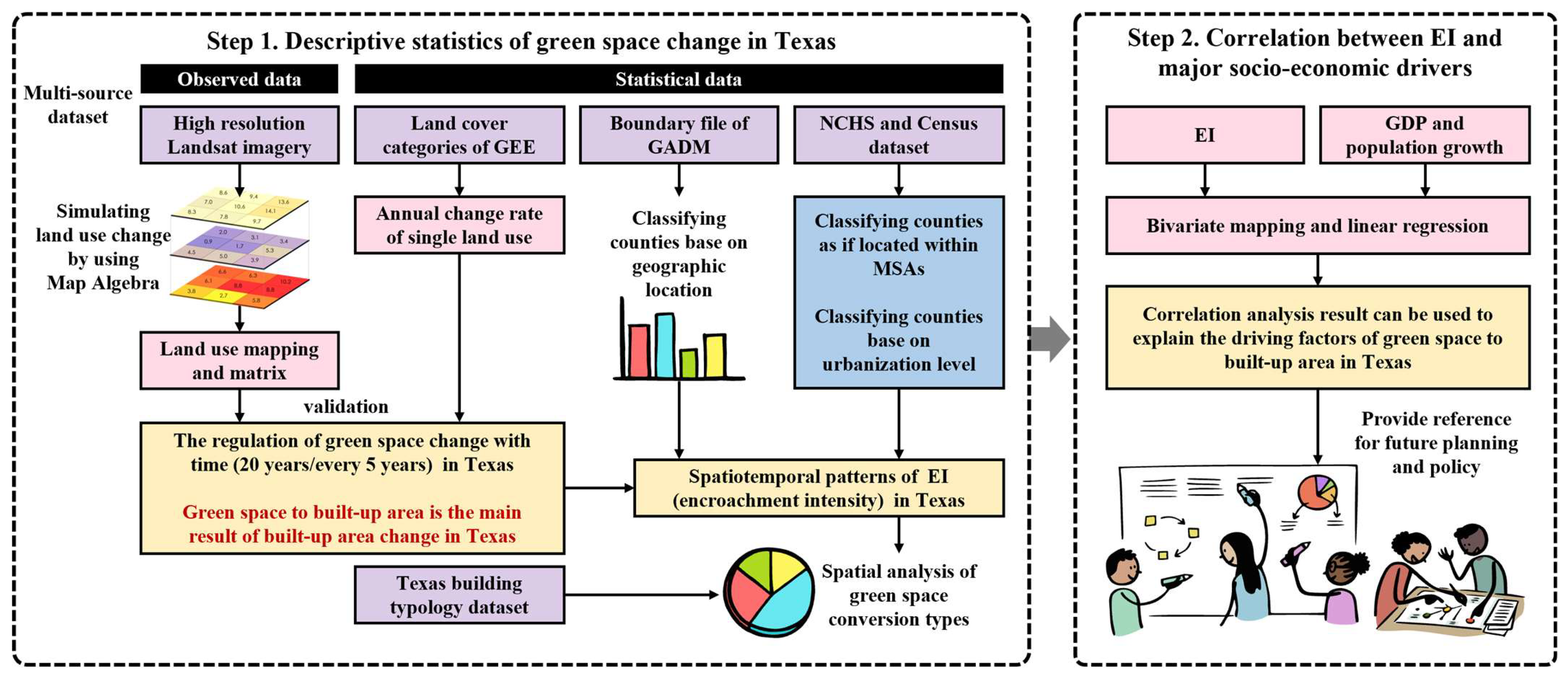
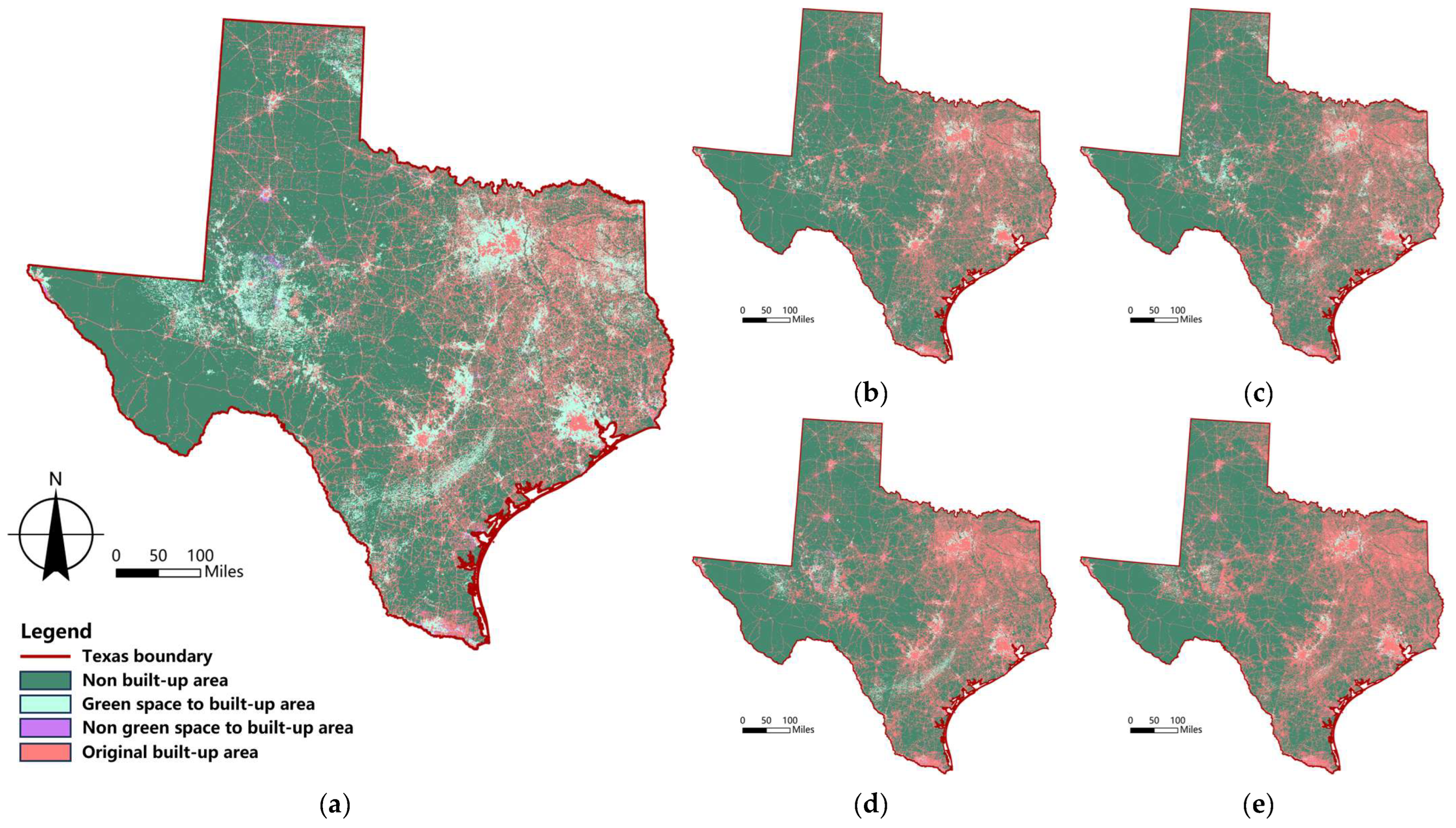
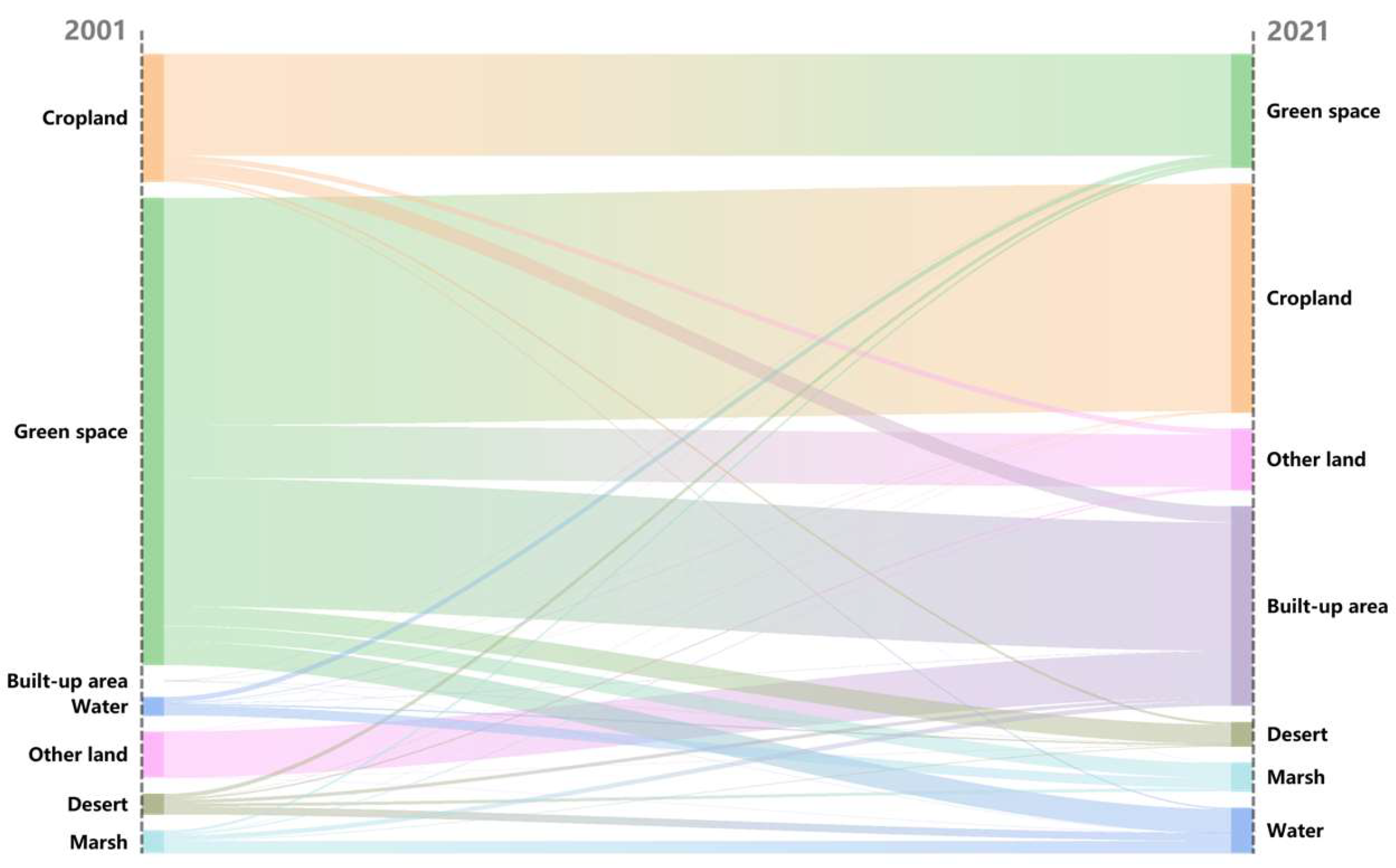

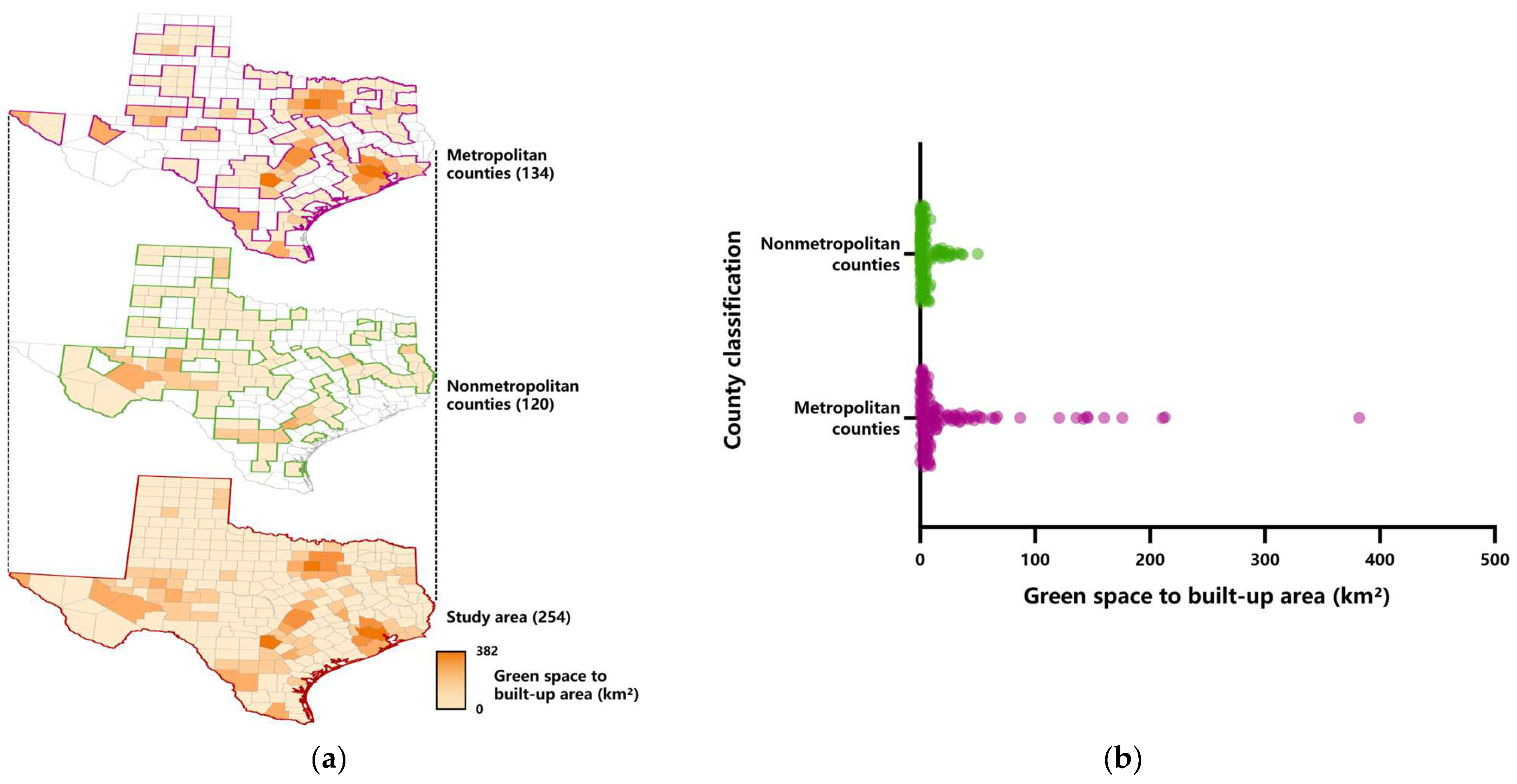

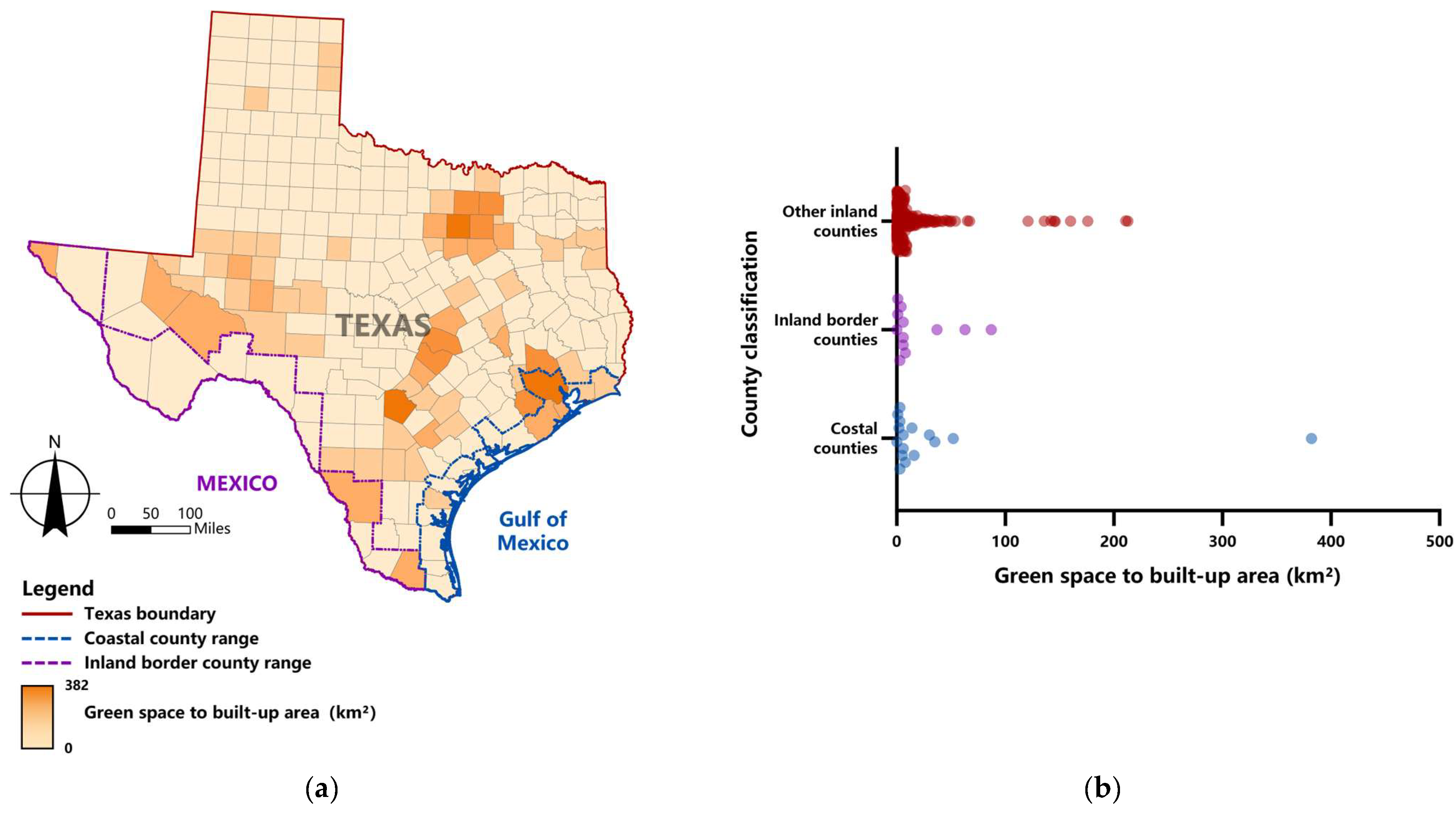
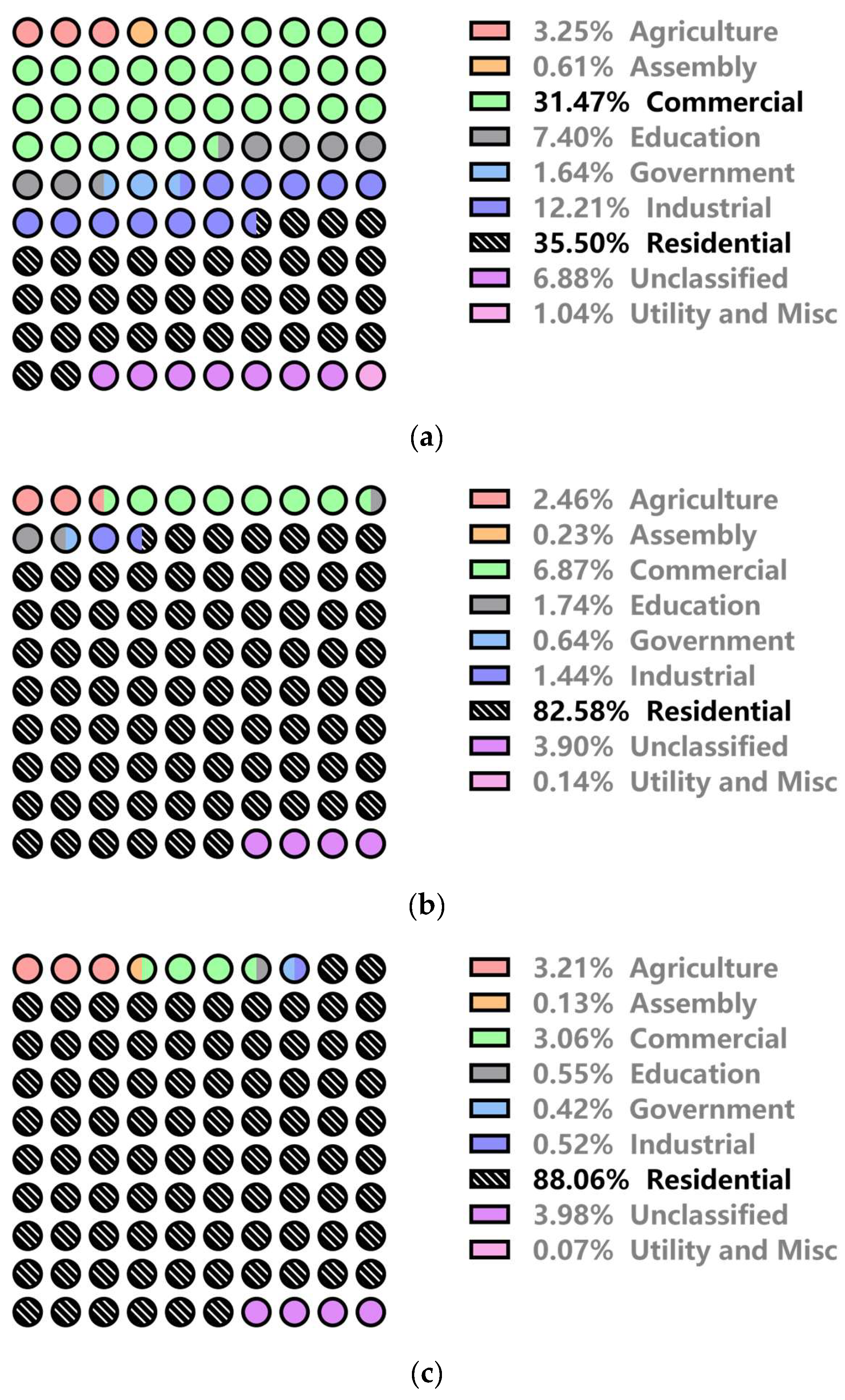
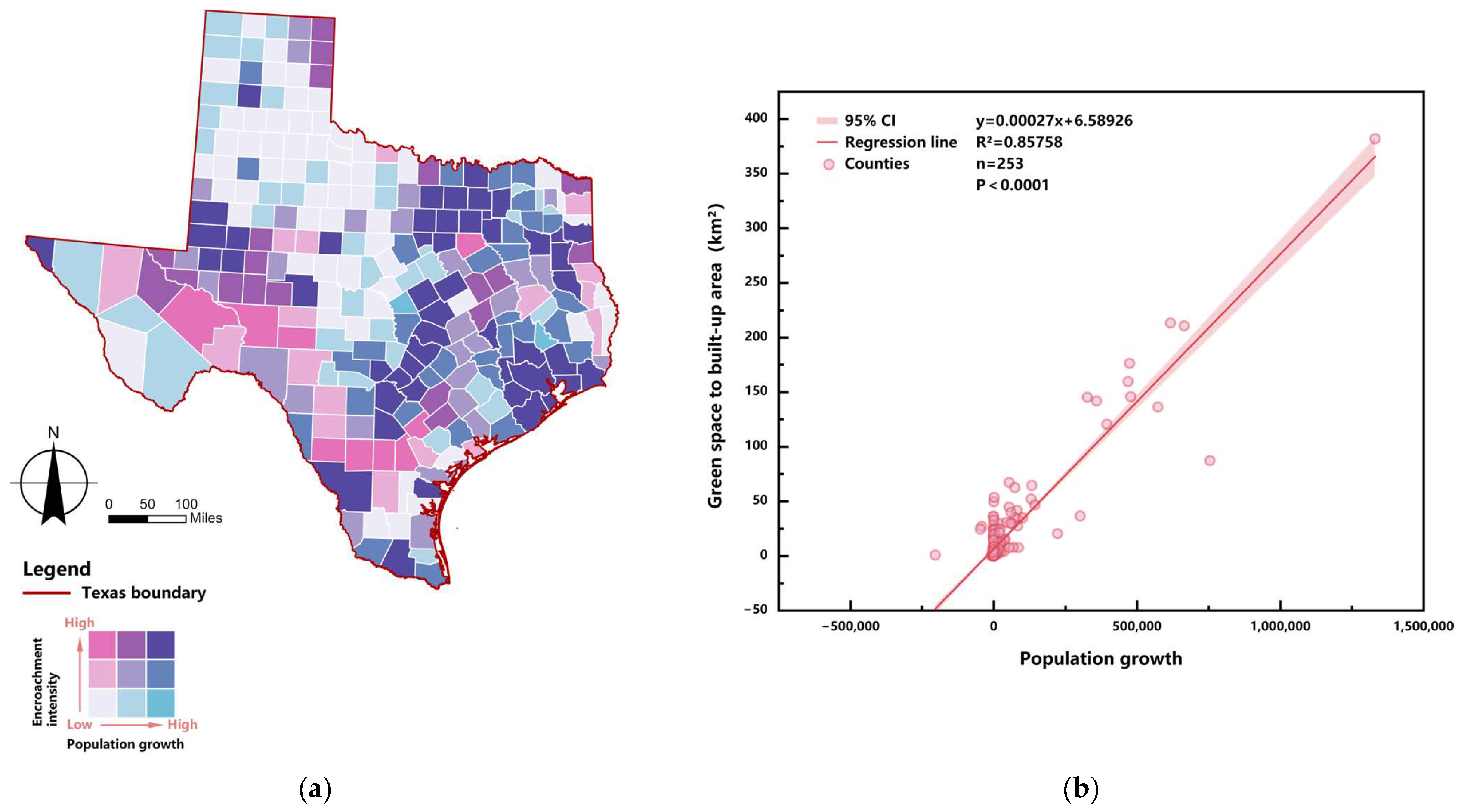
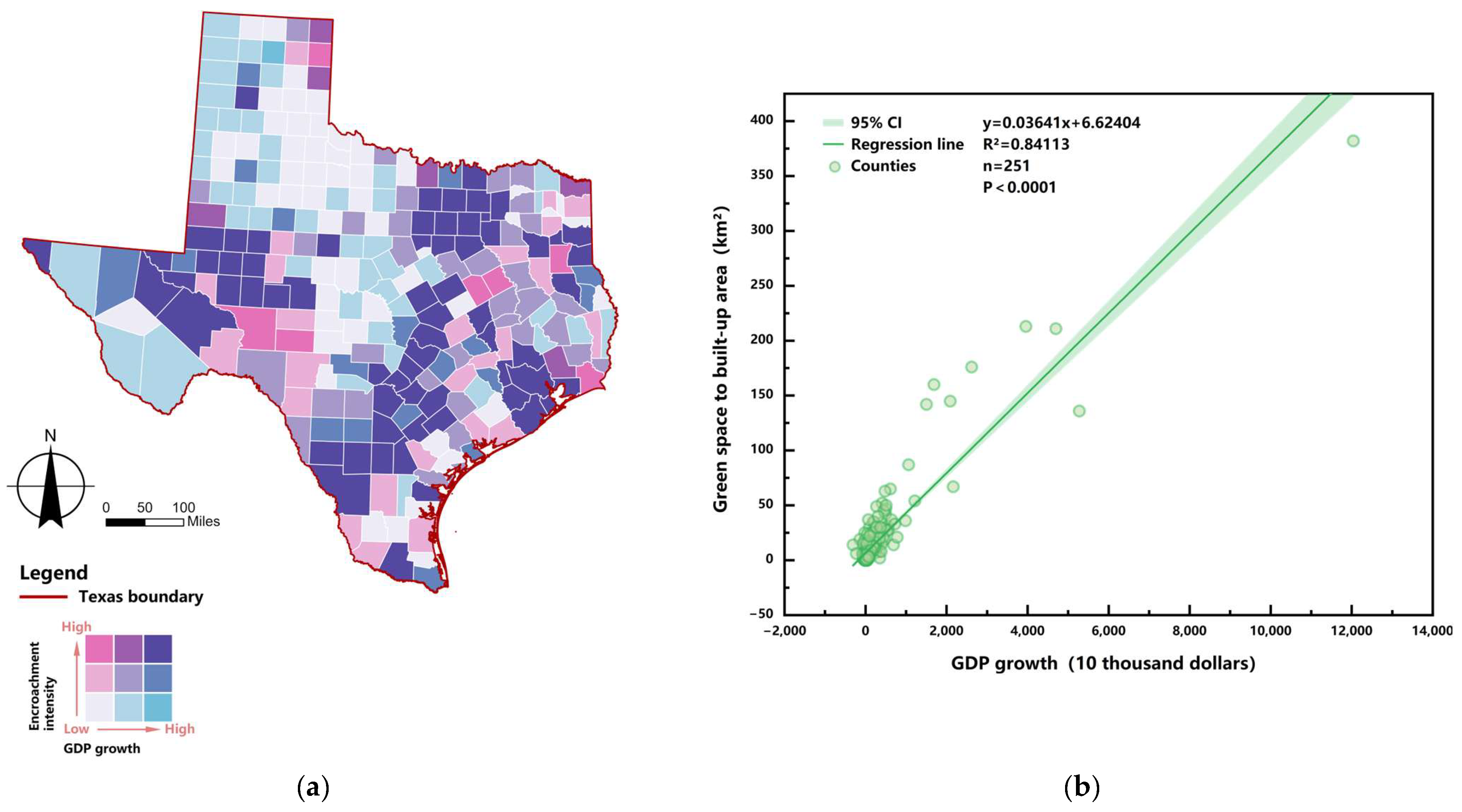
| Metropolitan Counties | Nonmetropolitan Counties | ||
|---|---|---|---|
| Descriptive statistics | Classification rules | Counties situated within MSAs | Counties outside of MSAs |
| Number of counties | 134 | 120 | |
| Total land (km2) | 341,039 | 345,174 | |
| Total change (km2) | 3385 | 706 | |
| Intensity of changes | 1.0% | 0.2% | |
| Differentiation analysis | Mann–Whitney test | p value < 0.001 | |
| Large Metropolitan Counties | Small-to-Medium Metropolitan Counties | Nonmetropolitan Counties | ||
|---|---|---|---|---|
| Descriptive statistics | Classification rules | Counties situated within MSAs with populations exceeding one million | Counties situated within MSAs with populations below one million | Counties outside of MSAs |
| Number of counties | 6 | 128 | 120 | |
| Total land (km2) | 17,452 | 323,587 | 345,174 | |
| Total change (km2) | 1209 | 2175 | 701 | |
| Intensity of changes | 6.9% | 0.7% | 0.2% | |
| Differentiation analysis | Kruskal–Wallis test | p value < 0.001 | ||
| Coastal Counties | Inland Border Counties | Inland Counties | ||
|---|---|---|---|---|
| Descriptive statistics | Classification rules | Counties located along the coastline | Counties located inland and along the U.S.-Mexico border | Counties located inland but not along the U.S.–Mexico border |
| Number of counties | 16 | 12 | 226 | |
| Total land (km2) | 37,258 | 80,674 | 568,281 | |
| Total change (km2) | 564 | 221 | 3300 | |
| Intensity of changes | 1.5% | 0.3% | 0.6% | |
| Differentiation analysis | Kruskal–Wallis test | p value = 0.2592 | ||
Disclaimer/Publisher’s Note: The statements, opinions and data contained in all publications are solely those of the individual author(s) and contributor(s) and not of MDPI and/or the editor(s). MDPI and/or the editor(s) disclaim responsibility for any injury to people or property resulting from any ideas, methods, instructions or products referred to in the content. |
© 2025 by the authors. Licensee MDPI, Basel, Switzerland. This article is an open access article distributed under the terms and conditions of the Creative Commons Attribution (CC BY) license (https://creativecommons.org/licenses/by/4.0/).
Share and Cite
Ma, T.; Ye, H.; Lai, Y.; Han, H.; Song, Y.; Chen, Y. Spatiotemporal Dynamics and Driving Factors of Urban Green Space in Texas (2001–2021): A Multi-Source Geospatial Analysis. Buildings 2025, 15, 1166. https://doi.org/10.3390/buildings15071166
Ma T, Ye H, Lai Y, Han H, Song Y, Chen Y. Spatiotemporal Dynamics and Driving Factors of Urban Green Space in Texas (2001–2021): A Multi-Source Geospatial Analysis. Buildings. 2025; 15(7):1166. https://doi.org/10.3390/buildings15071166
Chicago/Turabian StyleMa, Tengfei, Huakai Ye, Yujing Lai, Haoying Han, Yangguang Song, and Yile Chen. 2025. "Spatiotemporal Dynamics and Driving Factors of Urban Green Space in Texas (2001–2021): A Multi-Source Geospatial Analysis" Buildings 15, no. 7: 1166. https://doi.org/10.3390/buildings15071166
APA StyleMa, T., Ye, H., Lai, Y., Han, H., Song, Y., & Chen, Y. (2025). Spatiotemporal Dynamics and Driving Factors of Urban Green Space in Texas (2001–2021): A Multi-Source Geospatial Analysis. Buildings, 15(7), 1166. https://doi.org/10.3390/buildings15071166









